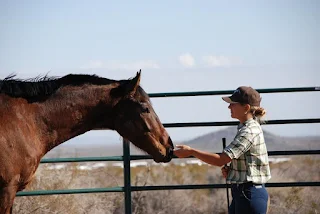I had a recent inquiry about horse behavior and thought I'd share my perspective.
Question:
How do you stop playing/exuberant behaviour from turning into a fight or flight reaction without eradicating the fun aspect?
Answer:
I would start when the horse was loose- and reassess how the horse feels about you establishing spatial boundaries. There are many behaviors that the human interprets as playful- not realizing the horse is actually asking where the imaginary "boundary" is for them to "be" when in close proximity to you. You are not looking to "judge" or critique the horse's response- rather you're looking to assess if there is a defensiveness to when you say "no further."
Many times when someone initially creates a boundary (let's say by gently lifting a hand to indicate for the loose horse to stop, the horse "pushes" through with their nose and keeps coming at the human. SO, did he see you? Yes. Did your behavior mean anything? No. So then you have to experiment with gently increasing your energy to "take up" more space and for your horse to acknowledge the boundary (whether by slightly swinging a lead rope not attached to him, or casting it at him, etc.) The moment the horse backs off or pauses to acknowledge your behavior. You pause as the "thank you" towards his effort. Then often they might resort to pushing in spatially towards you again, and your job will be to assess how much follow through on your end does it take for him to mentally let go of barging in on you. (think of it as a search on your horse's end.)
Now he may be shocked at your follow-through in not letting him push into your space even if the boundary is 10 feet away from where you're standing- and he may run off and have a tantrum or otherwise because of you clear definition of the boundary, but eventually you'll see he'll sort himself out and start to soften his posture, decrease his energy and almost in a slow, intentional way approach you- as if "asking" if he may come closer in proximity.
The horse is learning the concept of spatial pressure and release. The more reasonable his behavior where he considers you, the more "release" he gets. So he will start to keep trying to find that place of release.
So how does this relate to playtime?. This is the beginning of his learning to believe you so that if he starts to get too "big" or "playful" you have a "pause" option that he recognizes.
Your horse has to be able to realize your "no" is a support tool in how you offer him guidelines and boundaries, rather than him being defensive towards it. That way, as he starts to get playful, when you say "no" or enough, it isn't the first time you are trying to establish it as an effective way to interact.
Similar to the horse herd leader who is always giving support, boundaries, and guidelines to the other horses as to "where" each horse in the herd needs to be and what behavior is appropriate or not. The same needs to be offered from the human towards the horse.
Then you can enjoy the playtime, and both you and the horse won't become overly engaged in getting into uncomfortable situations.



No comments:
Post a Comment
Thank you for visiting my blog and leaving a comment!
Sam